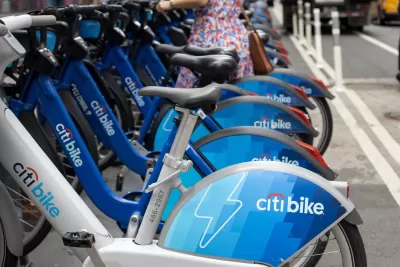Citi Bike’s e-bikes are becoming too popular for their own good as Lyft struggles to keep up with maintenance and charging.

After describing a frustrating experience with broken e-bikes, John Surico asks in a piece for Curbed, “Why can’t Citi Bike keep its e-bikes running?”
To answer this, Surico first debunks the commonly held belief that non-functioning bike are due to the poor behavior of teen riders. “According to Lyft, vandalism only accounts for a small portion of the issues downing the fleet. Instead, it says it’s the system in place that’s struggling to keep up.” Bikes designed for about 5 rides a day are seeing as many as 15 daily rides, dramatically reducing their lifespan.
Charging also takes bikes out of service and adds hours of travel time for bike mechanics. While Citi Bike has proposed considering charging at stations, “hooking up the stations to energy grids with enough electricity to power multiple bikes at once is complex, requiring city support.”
According to Surico, the company’s recent surge of hiring shows they’re trying to meet the growing demand for Citi Bike. “For now, maintaining the Citi Bike system remains a Herculean logistics game involving an army of hundreds scouring the streets of New York City 24/7 to visit some 1,800 stations.”
FULL STORY: Why Are Citi Bike’s Electric Bikes Always Broken?

Planetizen Federal Action Tracker
A weekly monitor of how Trump’s orders and actions are impacting planners and planning in America.

Trump Administration Could Effectively End Housing Voucher Program
Federal officials are eyeing major cuts to the Section 8 program that helps millions of low-income households pay rent.

The 120 Year Old Tiny Home Villages That Sheltered San Francisco’s Earthquake Refugees
More than a century ago, San Francisco mobilized to house thousands of residents displaced by the 1906 earthquake. Could their strategy offer a model for the present?

Washington State Legislature Passes Parking Reform Bill
A bill that would limit parking requirements for new developments is headed to the governor’s desk.

Missouri Law Would Ban Protections for Housing Voucher Users
A state law seeks to overturn source-of-income discrimination bans passed by several Missouri cities.

Op-Ed: Looking for Efficiency? Fund Intercity Buses
Much less expensive than rail, intercity buses serve millions of Americans every year, but public subsidies are lacking.
Urban Design for Planners 1: Software Tools
This six-course series explores essential urban design concepts using open source software and equips planners with the tools they need to participate fully in the urban design process.
Planning for Universal Design
Learn the tools for implementing Universal Design in planning regulations.
Ada County Highway District
Clanton & Associates, Inc.
Jessamine County Fiscal Court
Institute for Housing and Urban Development Studies (IHS)
City of Grandview
Harvard GSD Executive Education
Toledo-Lucas County Plan Commissions
Salt Lake City
NYU Wagner Graduate School of Public Service





























